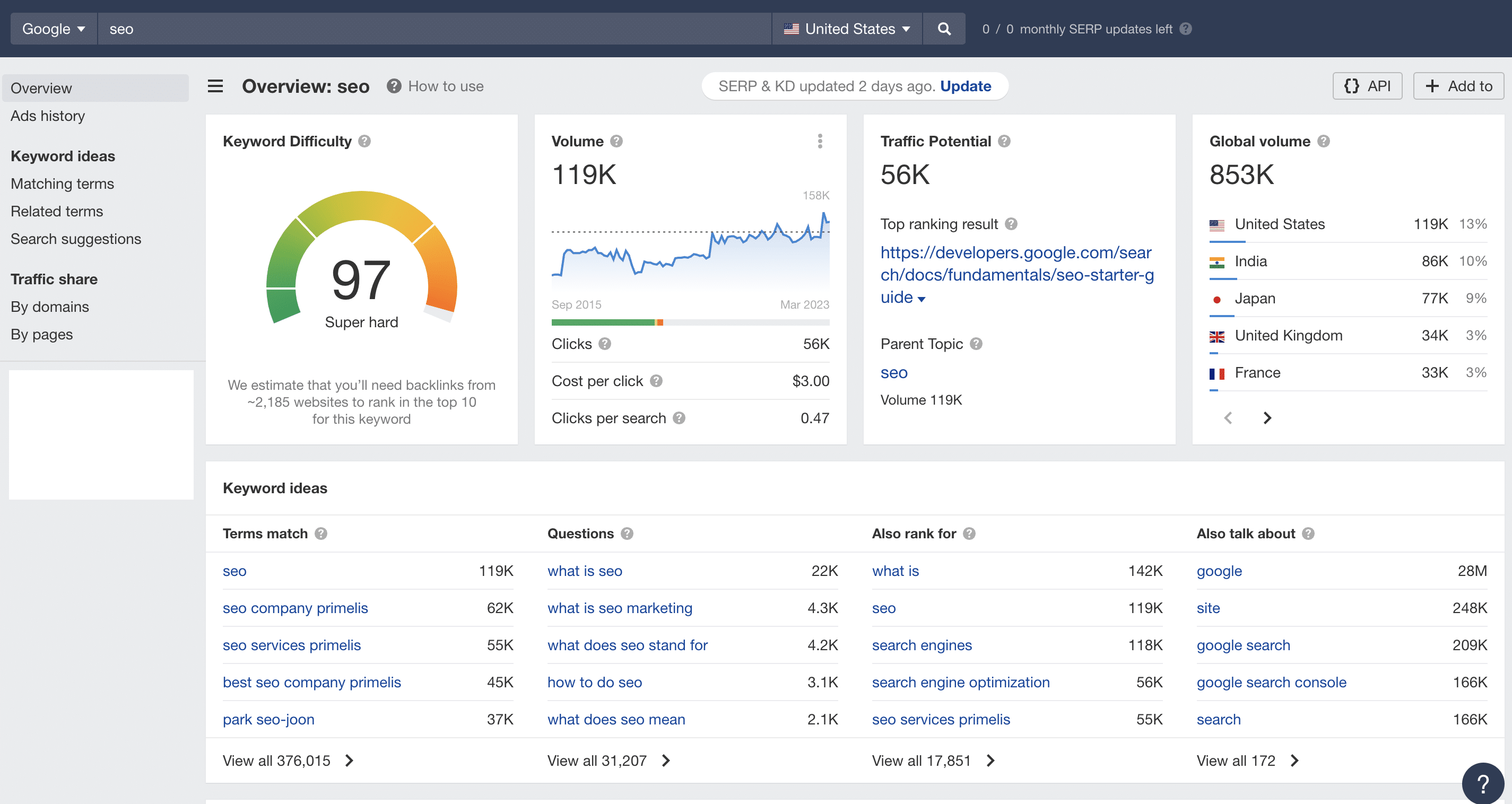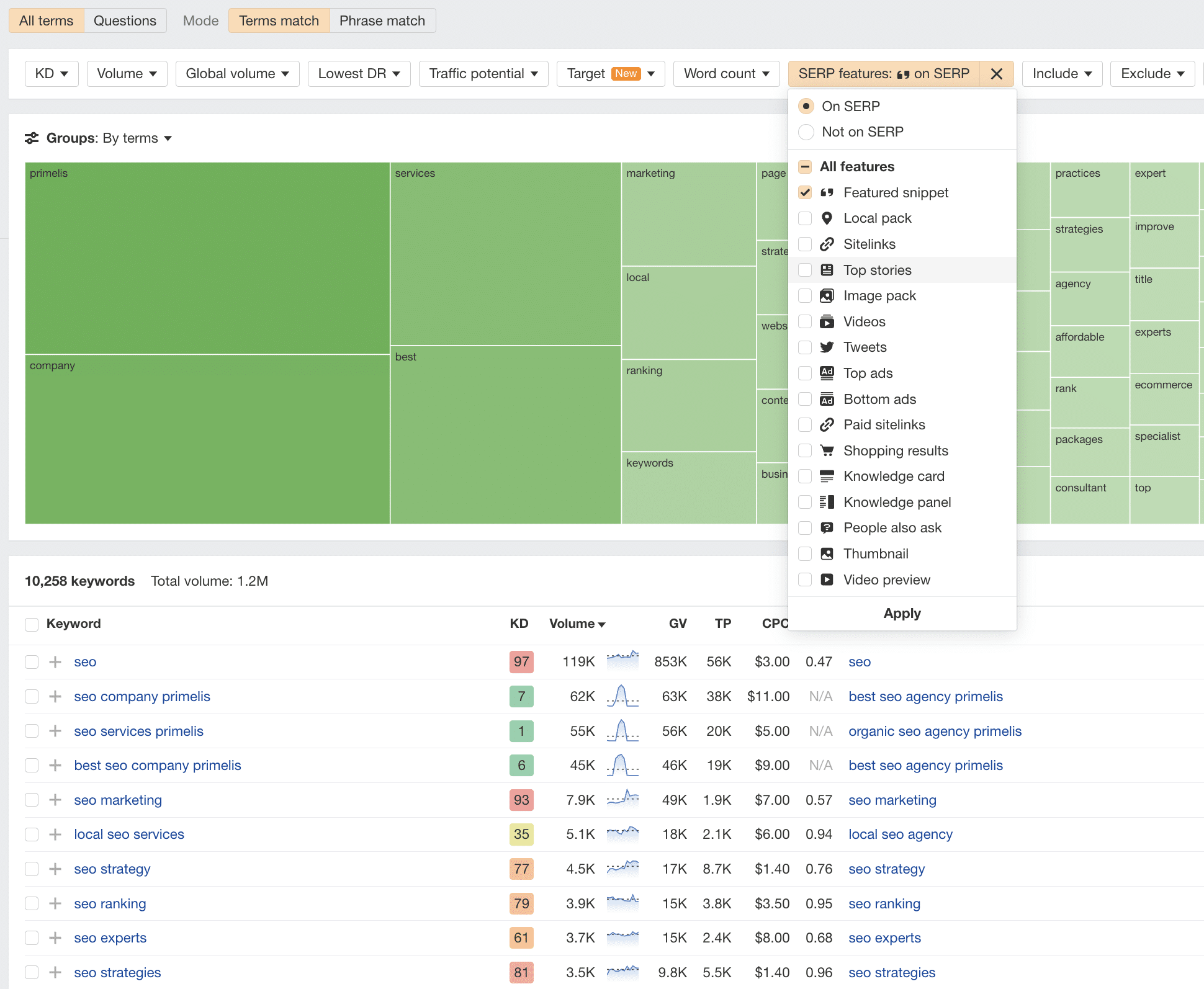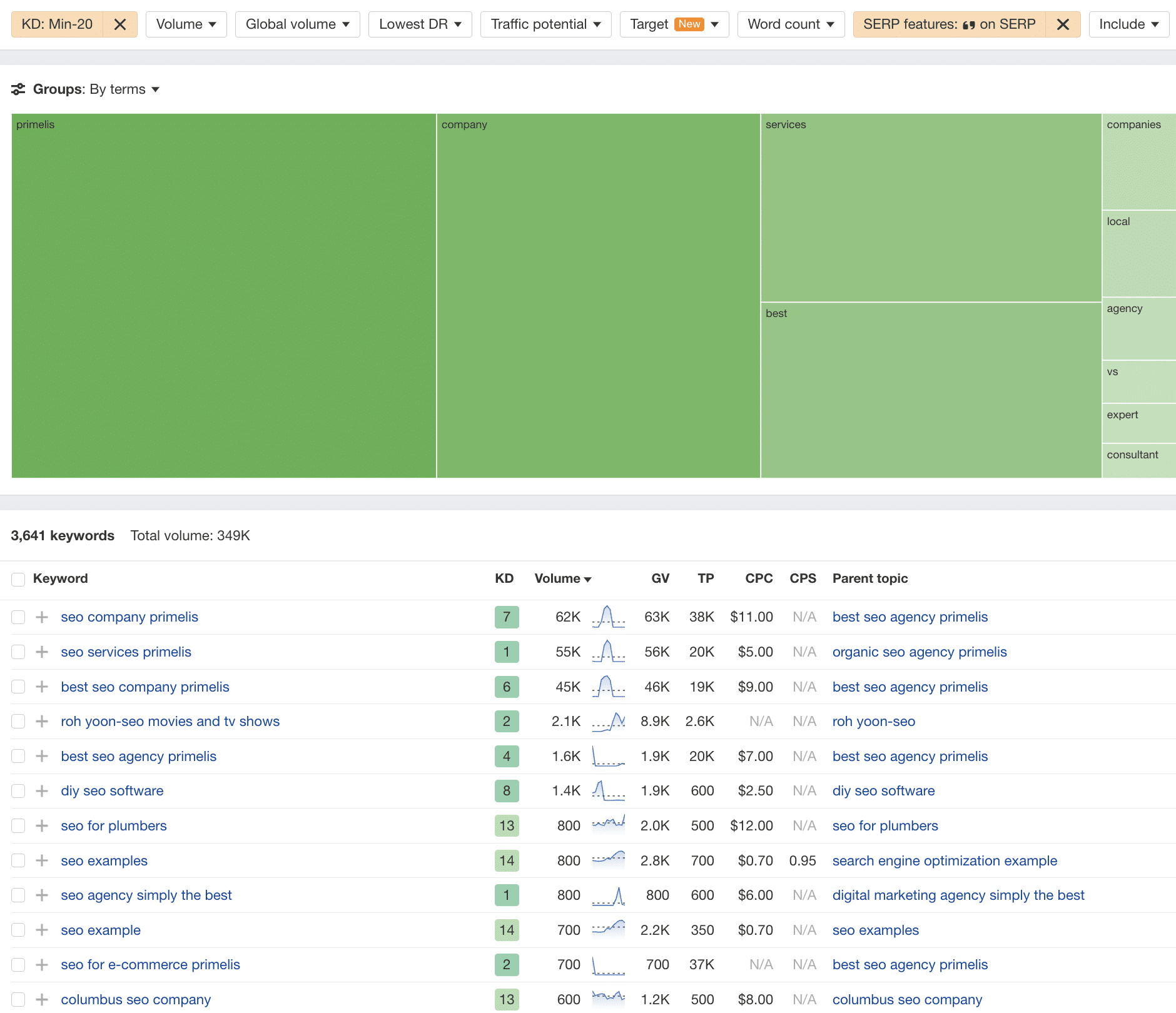If you are a SaaS business owner or marketer, you know how challenging it is to stand out in the crowded and competitive online space. That’s why you need to master SaaS SEO, which is the process of optimizing your website and content for search engines, so that you can attract more organic traffic, leads, and customers.
SaaS SEO is not the same as regular SEO. It has its own unique challenges and opportunities that require a different approach and strategy. For instance, SaaS businesses often have:
- A longer and more complex sales cycle that involves multiple touchpoints and decision-makers
- A higher customer lifetime value (CLV) that requires a focus on retention and loyalty
- A lower search volume and higher competition for niche and branded keywords
- A need to educate and persuade prospects about the value and benefits of their software solution
- A dynamic and evolving product that requires constant updates and improvements
The benefits of SaaS SEO are clear:
- It increases your brand awareness and visibility on search engines, which are the primary source of online traffic
- It generates qualified leads that are actively looking for a solution to their problem or need
- It reduces your customer acquisition costs (CAC) by leveraging free and organic channels
- It boosts your revenue by increasing your conversions, retention, and referrals
But how do you master SaaS SEO in 2023? What are the best practices and strategies that can help you achieve the best results? What are the tools and resources that can help you with your SaaS SEO efforts?
That’s what this comprehensive guide is all about. In this guide, we will cover everything you need to know about SaaS SEO in 2023.
SaaS SEO Best Practices
Before we dive into the specific strategies and tactics for SaaS SEO, let’s first review some of the essential SaaS SEO best practices that can help you improve your website and content performance. These are the foundational elements that can make or break your SaaS SEO success.
Technical SEO

Technical SEO is the process of optimizing your website’s performance, security, crawlability, indexability, and user experience. It ensures that your website is fast, secure, easy to navigate, and error-free. It also ensures that your website is properly structured and formatted for search engines to understand and rank.
Some of the technical SEO aspects that you need to pay attention to are:
Site Speed
This indicates how fast your website loads on different devices and browsers. Site speed affects both user experience and search engine rankings. According to Google, a one-second delay in mobile load time can impact conversion rates by up to 20%. To improve your site speed, you can use tools like Google PageSpeed Insights or GTmetrix to analyze and optimize your site’s performance.
Site Security
This factor indicates how secure your website is from hackers, malware, and other threats. Site security affects both user trust and search engine rankings. According to Google, HTTPS (Hypertext Transfer Protocol Secure) is a ranking signal. To improve your site security, you need to install an SSL (Secure Sockets Layer) certificate on your website, which encrypts the data between your server and your visitors’ browsers.
Site Structure
This indicates how well your website is organized and interlinked. Site structure affects both user navigation and search engine crawlability. A good site structure helps users find what they are looking for easily and quickly. It also helps search engines understand the hierarchy and relationship of your pages.
To improve your site structure, you need to use clear and descriptive URLs, headings, and breadcrumbs. You also need to create a sitemap, which is a file that lists all the pages on your website and their importance. You can use tools like Screaming Frog or XML Sitemaps to create and submit your sitemap to Google Search Console.
Site Markup
This factor indicates how well your website is formatted and coded for search engines to read and display. Site markup affects both user experience and search engine rankings. A good site markup helps users see relevant and rich information about your website on the search results page, such as title, description, ratings, reviews, images, etc.
It also helps search engines understand the content and context of your pages. To improve your site markup, you need to use schema.org, which is a standardized vocabulary that defines different types of entities and properties on the web. You can use tools like Rich Results Test or Schema Validator to test your schema markup.
Keyword Research

Keyword research is the process of finding and targeting the right keywords for different stages of the buyer journey and different types of content. Keywords are the words and phrases that users type into search engines to find what they are looking for. Keyword research helps you understand the intent, demand, and competition for each keyword, so that you can optimize your content accordingly.
Some of the keyword research aspects that you need to pay attention to are:
Keyword types
These are the different types of keywords that match different user intents and content formats. Keyword types include:
- Branded keywords: keywords that contain your brand name or variations of it. For example, “Saasmatic.io”, “Saasmatic app”, “Saasmatic”, etc. Branded keywords indicate high brand awareness and loyalty, and usually have high conversion rates.
- Niche keywords: keywords that are specific to your industry, niche, or product category. For example, “project management software”, “collaboration tool”, “team management app”, etc. Niche keywords indicate high relevance and interest, and usually have moderate competition and conversion rates.
- Long-tail keywords: keywords that are longer and more specific than niche keywords. For example, “best project management software for small teams”, “how to use collaboration tool for remote work”, “team management app with time tracking feature”, etc. Long-tail keywords indicate high intent and specificity, and usually have low competition and high conversion rates.
Keyword stages
These are the different stages of the buyer journey that match different user needs and goals. The buyer journey is the process that a user goes through from becoming aware of a problem or need, to evaluating different solutions, to making a purchase decision. Keyword stages include:
- Awareness stage: the stage where the user is aware of a problem or need, but not yet aware of the solution. For example, “how to manage projects effectively”, “how to improve team collaboration”, “how to track team productivity”, etc. Awareness stage keywords indicate low intent and awareness, and usually have high search volume and low conversion rates.
- Consideration stage: the stage where the user is aware of the solution, but not yet aware of the best option. For example, “project management software comparison”, “collaboration tool features”, “team management app reviews”, etc. Consideration stage keywords indicate moderate intent and awareness, and usually have moderate search volume and conversion rates.
- Decision stage: the stage where the user is aware of the best option, but not yet ready to make a purchase decision. For example, “Saasmatic pricing”, “Saasmatic services”, “Saasmatic packages”, etc. Decision stage keywords indicate high intent and awareness, and usually have low search volume and high conversion rates.
Keyword tools
These are the tools that can help you find and analyze keywords for your SaaS SEO campaign. Keyword tools help you discover new keyword opportunities, measure keyword difficulty and opportunity, track keyword rankings and performance, etc. Some of the best keyword tools for SaaS SEO are:
- Ahrefs: a comprehensive SEO tool that offers a powerful keyword explorer feature that allows you to find thousands of relevant keywords for any topic or niche, along with their search volume, difficulty, click-through rate (CTR), return rate (RR), parent topic (PT), etc. Ahrefs also allows you to analyze your competitors’ keywords, find keyword gaps and opportunities, track your keyword rankings over time, etc.
- Semrush: another comprehensive SEO tool that offers a robust keyword magic tool feature that allows you to find millions of relevant keywords for any topic or niche, along with their search volume, difficulty, trend, CTR potential (CPC), competitive density (KD), SERP features (SF), etc. Semrush also allows you to analyze your competitors’ keywords, find keyword gaps and opportunities, track your keyword rankings over time, etc.
- AnswerThePublic: a free keyword tool that allows you to find hundreds of questions, prepositions, comparisons, related terms, etc., for any topic or niche. AnswerThePublic helps you uncover user intent and pain points behind each keyword, along with their search volume, difficulty, and SERP features. AnswerThePublic helps you create content that answers user queries and matches user intent.
Content Marketing

Content marketing is the process of creating and distributing valuable, relevant, and engaging content that attracts and converts prospects into customers. It helps you educate and persuade your audience about the value and benefits of your software solution, as well as to build trust and authority in your niche.
Some of the content marketing aspects that you need to pay attention to are:
Content types
These are the different types of content that match different user intents and content formats. Content types include:
- Blog posts: long-form articles that provide in-depth information, insights, tips, etc., on a specific topic or niche. Blog posts are ideal for awareness and consideration stage keywords, as well as for topic clusters and featured snippets.
- Ebooks: longer and more comprehensive documents that cover a broader topic or niche. Ebooks are ideal for decision stage keywords, as well as for lead magnets and email marketing.
- Webinars: live or recorded presentations that demonstrate or teach something related to your product or niche. Webinars are ideal for decision stage keywords, as well as for lead generation and nurturing.
- Case studies: stories that showcase how your customers have used your product to solve their problems or achieve their goals. Case studies are ideal for decision stage keywords, as well as for social proof and testimonials.
- Videos: short or long videos that provide visual and auditory information, entertainment, or education on a specific topic or niche. Videos are ideal for awareness and consideration stage keywords, as well as for video marketing and user engagement.
Content quality
How well your content provides value, relevance, and engagement to your audience. Content quality affects both user experience and search engine rankings. A good content quality helps users find what they are looking for easily and quickly, as well as to stay longer and interact more with your content. It also helps search engines understand the content and context of your pages, as well as to rank them higher for relevant queries. To improve your content quality, you need to follow these guidelines:
- Write original and unique content that is not copied or duplicated from other sources
- Write informative and comprehensive content that covers all the aspects of the topic or niche
- Write clear and concise content that is easy to read and understand
- Write engaging and creative content that captures the attention and interest of the audience
- Write accurate and factual content that is supported by credible sources and data
- Write optimized and structured content that follows SEO best practices, such as using keywords, headings, subheadings, lists, tables, images, etc.
Content distribution
How well you promote and share your content with your target audience and potential customers. Content distribution helps you increase your reach, visibility, and traffic for your content, as well as to generate more leads and conversions. To improve your content distribution, you need to use these channels:
- Email marketing: sending personalized and relevant emails to your subscribers that provide value, information, or offers related to your product or niche. Email marketing helps you build relationships with your audience, nurture them through the buyer journey, and increase conversions and retention.
- Social media marketing: posting engaging and shareable content on various social media platforms that provide value, information, or entertainment related to your product or niche. Social media marketing helps you increase your brand awareness, reach new audiences, drive traffic to your website, and generate social signals.
- Guest blogging: writing high-quality articles for other reputable websites or blogs in your niche that provide value, information, or insights related to your product or niche. Guest blogging helps you increase your authority, credibility, exposure, traffic, and backlinks.
- Influencer marketing: collaborating with influential people in your niche who have a large and loyal following that trust their opinions and recommendations. Influencer marketing helps you increase your brand awareness, reach new audiences, drive traffic to your website, and increase conversions and referrals.
Link Building

Link building is the process of acquiring high-quality backlinks from authoritative and relevant sources that boost your site’s authority and trustworthiness. Backlinks are links from other websites that point to your website. Link building helps you improve your search engine rankings, as well as to drive referral traffic, leads, and customers to your website.
Some of the link building aspects that you need to pay attention to are:
Link quality
How valuable, relevant, and trustworthy the link source is. Link quality affects both user experience and search engine rankings. A good link quality helps users find useful and reliable information related to your product or niche. It also helps search engines evaluate the popularity and credibility of your website. To improve your link quality, you need to follow these guidelines:
- Get links from high-authority websites that have a strong reputation and influence in your niche
- Get links from relevant websites that have a similar topic or audience to yours
- Get links from diverse websites that have different domains, IPs, locations, etc.
- Get links from natural websites that have editorial control and do not sell or exchange links
Link quantity
How many backlinks you have from different sources. Link quantity affects both user experience and search engine rankings. A good link quantity helps users find more information and resources related to your product or niche. It also helps search engines measure the popularity and visibility of your website. To improve your link quantity, you need to follow these guidelines:
- Get links from as many sources as possible, as long as they are high-quality and relevant
- Get links from different types of sources, such as blogs, news sites, directories, forums, social media, etc.
- Get links from different types of pages, such as homepages, category pages, product pages, blog posts, etc.
- Get links from different types of anchors, such as branded anchors, niche anchors, long-tail anchors, etc.
Link strategies
The different methods and techniques that can help you acquire backlinks for your website. Link strategies include:
- Content-based link building: creating and promoting high-quality content that attracts and earns backlinks from other websites. This includes blog posts, ebooks, webinars, case studies, videos, etc.
- Outreach-based link building: contacting and building relationships with other website owners or influencers in your niche who can link to your website. This includes guest blogging, influencer marketing, email outreach, etc.
- Resource-based link building: finding and filling gaps or opportunities in existing resources or content that can link to your website. This includes link insertions, unlinked mentions, skyscraper technique, etc.
SaaS SEO Strategies
Now that we have covered some of the essential SaaS SEO best practices, let’s move on to some of the specific strategies and tactics that can help you achieve the best results for your SaaS SEO campaign. These are the advanced techniques that can give you a competitive edge in the market.
Topic Clusters
Topic clusters are a way of organizing and interlinking related content around a core topic, creating a semantic relationship that signals relevance and authority to search engines. Topic clusters consist of:
- A pillar page: a comprehensive and authoritative page that covers all the aspects of a core topic or niche. For example, “SaaS SEO: The Ultimate Guide”.
- Cluster pages: several supporting pages that cover specific subtopics or keywords related to the core topic or niche. For example, “Technical SEO for SaaS”, “Keyword Research for SaaS”, “Content Marketing for SaaS”, etc.
- Internal links: links that connect the pillar page with the cluster pages, and vice versa.
Topic clusters help you rank for both broad and specific keywords related to your product or niche. They also help you provide a better user experience by making it easier for users to find relevant and comprehensive information on your website.
To create topic clusters for your SaaS SEO campaign, you need to follow these steps:
Step 1: Identify your core topic or niche
This is the main topic or niche that defines your product or service. For example, “project management software”, “collaboration tool”, “team management app”, etc.
Step 2: Find your pillar keyword
This is the main keyword that represents your core topic or niche. For example, “project management software”, “collaboration tool”, “team management app”, etc.
Step 3: Create your pillar page
This is the page that covers all the aspects of your core topic or niche in detail. For example, “SaaS SEO: The Ultimate Guide”. Your pillar page should include:
- A catchy and descriptive title that includes your pillar keyword
- A compelling introduction that explains what your core topic or niche is and why it is important
- A table of contents that outlines the main sections and subtopics of your pillar page
- A comprehensive and informative body that covers all the subtopics and keywords related to your core topic or niche
- A clear and concise conclusion that summarizes the main points of your pillar page and provides a call-to-action
- A list of internal links that point to your cluster pages, and vice versa
Step 4: Find your cluster keywords
These are the keywords that represent the specific subtopics or keywords related to your core topic or niche. For example, “technical SEO for SaaS”, “keyword research for SaaS”, “content marketing for SaaS”, etc. You can use keyword tools like Ahrefs to find relevant cluster keywords for your core topic or niche.
Step 5: Create your cluster pages
These are the pages that cover specific subtopics or keywords related to your core topic or niche in detail. For example, “Technical SEO for SaaS”, “Keyword Research for SaaS”, “Content Marketing for SaaS”, etc. Your cluster pages should include all the same elements that we outlined for the pillar pages.
Featured Snippets
Featured snippets are rich results that appear at the top of the search results page, providing a quick answer to a user’s query. Featured snippets can be in different formats, such as paragraphs, lists, tables, videos, etc. Featured snippets help you increase your visibility, traffic, and authority on search engines, as well as to provide a better user experience by answering user queries directly on the search results page.
To optimize your content for featured snippets, you need to follow these guidelines:
Identify featured snippet opportunities
These are the queries that trigger featured snippets on search engines. You can use tools like Ahrefs to find opportunities for your product or niche. You can also use AnswerThePublic to find questions related to your product or niche.
Here is a quick example on how to use Ahrefs for finding Featured Snippets opportunities for the SEO niche:
First, go to Keyword Explorer. Then, type in “SEO” and wait for the report to generate.

We can see that this keyword is very difficult. Let’s try filtering for Featured Snippet opportunities. Go to the Matching Terms report and go to the SERP features filter, where you can choose “Featured Snippet”. Make sure to tick “On SERP” as well.

We can see that the keywords are kinda tough, so here is a neat trick! We will use the KD filter and set it to be at 20 KD max. This will generate a report of easier keywords that are easier to rank for. Of course, make sure to perform qualitative SEO analysis to check what kind of content will rank.

Match the featured snippet format
These are the formats that match the user intent and query type. You need to use the same format as the existing featured snippet, or a better one if possible. For example:
- For question queries, use paragraphs or lists
- For comparison queries, use tables or lists
- For how-to queries, use lists or videos
Provide a clear and concise answer
This is the answer that provides value, relevance, and engagement to the user. You need to provide a clear and concise answer that answers the user query directly and completely. For example:
- Use bullet points or numbers for lists
- Use headings or subheadings for paragraphs
- Use rows and columns for tables
Optimize your content for SEO
This is the content that follows SEO best practices, such as using keywords, headings, subheadings, lists, tables, images, etc. You need to optimize your content for SEO so that search engines can understand and rank it better. For example:
- Use your target keyword in the title, URL, and first paragraph of your content
- Use related keywords and synonyms throughout your content
- Use schema markup to structure and format your content
Link-bait posts
Link-bait posts are posts that are designed to attract and earn backlinks from other websites. Link-bait posts are usually high-quality, original, and valuable content that provide something unique, useful, or interesting to the audience. Link-bait posts help you increase your authority, credibility, exposure, traffic, and backlinks.
Some of the types of link-bait posts that you can create for your SaaS SEO campaign are:
- Original research: posts that provide new data, insights, or findings on a specific topic or niche. For example, “Saasmatic.io Survey: How Link Building Can Impact Your Saas Growth in 2023”.
- Infographics: posts that provide visual information, statistics, or facts on a specific topic or niche. For example, “Saas Statistics: Trends and Facts for 2023”.
- Guides: posts that provide comprehensive and authoritative information on how to do something related to your product or niche. For example, “How to Use Saasmatic for Saas Growth: The Ultimate Guide”.
- Lists: posts that provide a number of items or resources related to your product or niche. For example, “50 Best Project Management Software Tools for 2023”.
- Controversial: posts that provide an opinion or perspective that challenges or contradicts the common or popular view on a specific topic or niche. For example, “Why Project Management Software is Overrated and How to Manage Projects Without It”.
To create link-bait posts for your SaaS SEO campaign, you need to follow these steps:
Identify your link-bait topic and goal
This is the topic and goal that defines your link-bait post. For example, “how project managers use project management software in 2023”, “project management software statistics”, etc.
Find your link-bait keyword
This is the keyword that represents your link-bait topic and goal. For example, “project management software survey”, “project management software infographic”, etc. You can use keyword tools like Ahrefs to find relevant link-bait keywords for your product or niche.
Create your link-bait content
This is the content that provides value, relevance, and engagement to your audience. For example:
- A post that shows the results of a survey on how project managers use project management software in 2023
- A post that shows an infographic on project management software statistics for 2023
Optimize your link-bait content for SEO
This is the content that follows SEO best practices, such as using keywords, headings, subheadings, lists, tables, images, etc. You need to optimize your link-bait content for SEO so that search engines can understand and rank it better. For example,
- Use your target keyword in the title, URL, and first paragraph of your content
- Use related keywords and synonyms throughout your content
- Use schema markup to structure and format your content
Promote your link-bait content
This is the process of sharing and spreading your link-bait content with your target audience and potential link partners. You need to promote your link-bait content so that you can increase your exposure, traffic, and backlinks. To promote your link-bait content, you need to use these channels:
- Email marketing: sending personalized and relevant emails to your subscribers that provide value, information, or offers related to your link-bait content.
- Social media marketing: posting engaging and shareable content on various social media platforms that provide value, information, or entertainment related to your link-bait content.
- Outreach-based link building: contacting and building relationships with other website owners or influencers in your niche who can link to your link-bait content.
User Intent
User intent is the goal or need behind a user’s search query. User intent helps you understand what the user is looking for, what they expect to find, and how they want to interact with your website or content. User intent affects both user experience and search engine rankings. A good user intent helps users find what they are looking for easily and quickly, as well as to have a satisfying experience with your website or content. It also helps search engines match your website or content with the most relevant queries.
To align your content with user intent, you need to follow these guidelines:
Identify user intent
This is the process of analyzing and categorizing user queries based on their intent. User intent can be classified into four main types:
- Informational intent: the user wants to find information or learn something about a topic or niche. For example, “what is project management software”, “how does project management software work”, “why use project management software”, etc.
- Navigational intent: the user wants to find a specific website or page related to a topic or niche. For example, “Saasmatic pricing”, “Saasmatic support”, etc.
- Transactional intent: the user wants to buy or sign up for something related to a topic or niche. For example, “buy project management software”, “project management software free trial”, “project management software demo”, etc.
- Commercial intent: the user wants to compare or evaluate different options related to a topic or niche before making a purchase decision. For example, “project management software comparison”, “project management software reviews”, “project management software features”, etc.
Match user intent
This is the process of creating and optimizing content that matches the user intent for each query type. You need to match user intent so that you can provide relevant and valuable content that meets the user needs and expectations. For example,
- For informational intent: create content that provides clear and comprehensive information or education on the topic or niche. Use content types like blog posts, ebooks, webinars, videos, etc.
- For navigational intent: create content that provides easy and quick access to the specific website or page that the user is looking for. Use content types like homepages, category pages, product pages, etc.
- For transactional intent: create content that provides compelling and persuasive offers or incentives that encourage the user to buy or sign up for something. Use content types like landing pages, sales pages, checkout pages, etc.
- For commercial intent: create content that provides unbiased and helpful comparisons or evaluations of different options that help the user make a purchase decision. Use content types like comparison pages, review pages, feature pages, etc.
SaaS SEO Tools and Resources
In this section, we will recommend some of the best tools and resources that can help you with your SaaS SEO efforts. These include SEO audit tools, content creation tools, and link building tools. By using these tools and resources, you will be able to streamline your workflow, automate your tasks, and measure your results. Check out our full list of best Saas SEO tools as well.
SEO Audit Tools
SEO audit tools are tools that help you analyze and improve your site’s technical SEO, keyword rankings, content quality, and backlink profile. SEO audit tools help you identify and fix any issues or errors that may affect your site’s performance and rankings.
Some of the best SEO audit tools for SaaS SEO are:
- Ahrefs: a comprehensive SEO tool that offers a powerful site audit feature that allows you to crawl and analyze your site’s health, performance, and issues. Ahrefs also allows you to monitor your site’s keyword rankings, traffic, backlinks, competitors, etc.
- Screaming Frog: a desktop-based SEO tool that allows you to crawl and analyze your site’s technical SEO aspects, such as URLs, titles, descriptions, headings, images, etc. Screaming Frog also allows you to generate and submit sitemaps, find and fix broken links, analyze page speed, etc.
- Google Search Console: a free web service by Google that allows you to monitor and maintain your site’s presence on Google search results. Google Search Console also allows you to submit your sitemap, check your site’s index status, find and fix crawl errors, analyze your site’s performance, etc.
Content Creation Tools
Content creation tools are tools that help you generate high-quality content ideas, optimize content for SEO, and measure content performance. Content creation tools help you create valuable, relevant, and engaging content that attracts and converts your audience.
Some of the best content creation tools for SaaS SEO are:
- BlogSEO.ai: a AI-powered content creation tool that helps you generate high-quality blog post ideas, outlines, and drafts for any topic or niche. BlogSEO.ai also helps you optimize your content for SEO, readability, and engagement.
- Frase.io: a AI-powered content creation tool that helps you create high-quality content that matches user intent and query type. Frase.io also helps you optimize your content for SEO, readability, and engagement.
- Grammarly: a writing assistant tool that helps you improve your writing skills, grammar, spelling, punctuation, etc. Grammarly also helps you optimize your content for tone, clarity, and style.
- Hemingway: a writing assistant tool that helps you improve your writing skills, readability, and simplicity. Hemingway also helps you optimize your content for sentence structure, word choice, and voice.
Link Building Tools
Link building tools are tools that help you find and outreach to potential link partners, manage link campaigns, and track link metrics. Link building tools help you acquire high-quality backlinks from authoritative and relevant sources that boost your site’s authority and trustworthiness.
Some of the best link building tools for SaaS SEO are:
- Hunter.io: a email finder tool that helps you find and verify email addresses of any website or person. Hunter.io also helps you outreach to potential link partners with personalized and relevant emails.
- Pitchbox: a outreach and link building tool that helps you find and contact influencers, bloggers, journalists, etc., who can link to your website. Pitchbox also helps you manage your link campaigns, track your link metrics, etc.
- Ahrefs: a comprehensive SEO tool that offers a powerful backlink analysis feature that allows you to analyze and monitor your site’s backlink profile, as well as your competitors’. Ahrefs also allows you to find link opportunities, track your link metrics, etc.
Good Luck With Your Saas SEO Efforts!
In this post, we have provided you with a comprehensive SaaS SEO guide that covers everything you need to know about SaaS SEO in 2023.
By following this guide, you will be able to master SaaS SEO in 2023 and grow your business online. Whether you are doing SEO for B2B SaaS or any other type of SaaS business, this guide will help you reach your goals and surpass your competitors.
If you don’t have time to perform the time-consuming (and sometimes nerve-consuming as well) task of Saas SEO – we are here to help you out!
Contact us and we will tailor a plan based on your needs! Let’s kick some serious a**!

